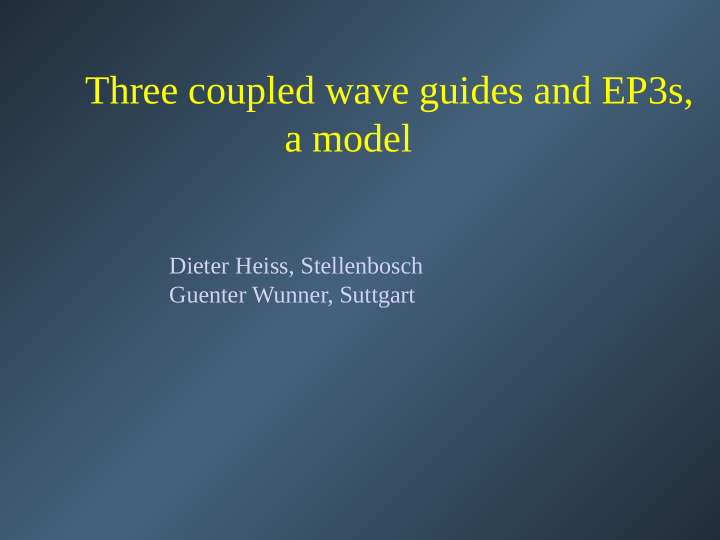



Three coupled wave guides and EP3s, a model Dieter Heiss, Stellenbosch Guenter Wunner, Suttgart
Extension of studies of EP2s for two wave guides Challenge: four real parameters to be adjusted to obtain EP3 EP3s have richer structure: if the interplay of parameters is not carefully tuned, they may split in either two neighbouring EP2s or three (complex) zeros sprout from the EP3 as they are rather elusive a considerable experimental challenge
For our model study we start from the equation which looks like a Schrödinger Eq but actually is the classical Helmholtz Eq for the electric fields for the three wave guides as in this cartoon (wave guides are perp to drawing plane) P-T symmetry
To obtain the eigenvalues k and eigen-fct we implement the (dis)continuity conditions for the wave fct at the delta functions. It yields three linear equs for the various coefficients needed for the wave fct, and the eig.values are the zeros of the determinant of that matrix. It is a transcendental equ. We are interested in the three lowest eigenvalues. We may call them the ‘bound states’, actually they are the possible modes of the three coupled wave guides. These solutions depend on the three parameters: Γ – the strength of the middle delta fct b – the distance, i.e. the coupling of the wave guides γ – the strength of the loss/gain term
As we have a PT-symmetric problem we expect real eigenvalues for some parameter values. Interesting physics is expected in the vicinity or at EP3s. real EP3s occur only for the interval 1 ≤ Γ ≤ 1.11… For increasing Γ an EP3 occurs as shown: k and b decrease, γ increases
When Γ > 1 we have, for γ = 0, three distinct real solutions if the other parameters are not tuned to give rise to an EP3. When γ is increased the three solutions are generically expected to remain real for a certain range of γ as we have P-T-symmetry.. Energies for Γ =1.002 and b =6.1, however…. for the last point b has to be changed to b =6.2… to avoid hitting an EP2 -- close to an EP3
Of interest are the wave functions: their real part must be symmetric under parity while their imaginary part must be anti-symmetric for γ = 0, Γ =1.002, b = 6.1, energies in descending order real part imaginary part
for γ = 0.02, Γ =1.002, b = 6.1, energies in descending order Note: with increasing γ the imaginary part of the wave fct sets in for the lowest and largest energy, while it is the real part for the intermediate level that switches on
At the point near to the EP3 the wave fcts look alike: Note also: the large scale as we use the c-normalisation, the c-norm vanishes at the EP Recall: for a non-hermitian Ham we have right hand and left hand eigenvectors (bi-orthogonality) forming the identity: and
Now we are prepared to look at the electric fields between the wave guides and into the drawing plane, we use for this coordinate `time` The propagation is given by
For γ =0, initial input only at middle wave guide For γ =0, initial input equal for all three wave guides, symmetry is lost.
When γ is increased the three levels get closer to each other, because the beat frequencies become smaller, watch scale. Here for γ = 0.02, b = 6.1. The specific initial conditions no longer matter greatly.
Near to the EP3 for γ = 0.065, b = 6.2.. Watch the scale: very small beat frequency
Conclusion: formally, you don’t expect any pattern AT the EP3 the elusiveness of the EP3 seems to be a particular experimental challenge the special effects known from EP2 non-adiabatic switch have not been studied as yet
The End The End Thank you for your attention
Recommend
More recommend